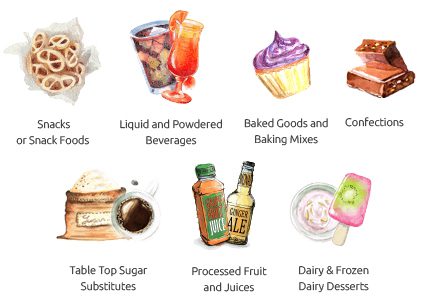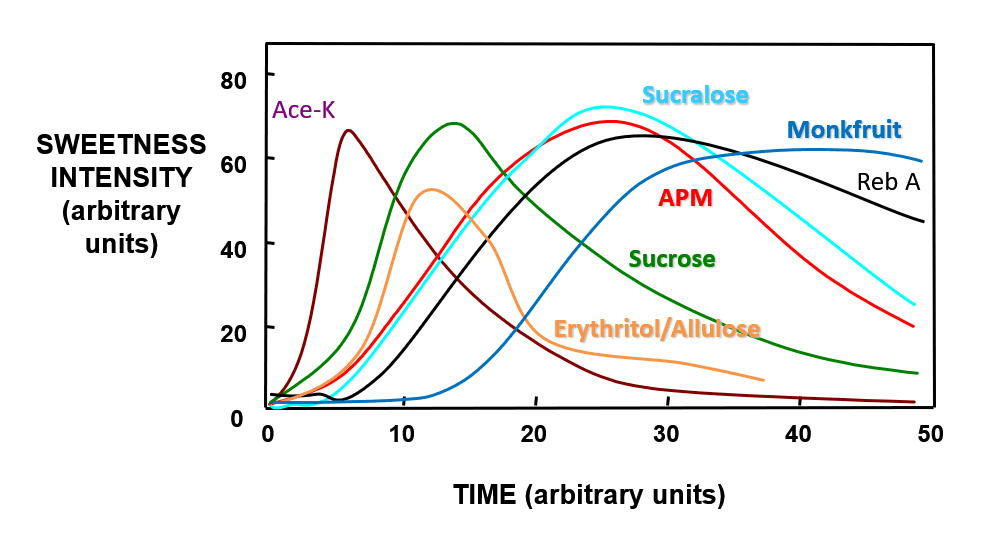The Science of Sweetness
SoPureTM Stevia Applications & Formula Development


SoPureTM offers the most complete portfolio of stevia extracts commercially available, but learning how to best use each of the different extracts is a study in the science of sweetness. From the more widely used Reb A to the less abundant, but slightly sweeter and better tasting Reb M, each of the glycosides found in stevia feature unique sweetness profiles and varying chemical traits, all which should be considered and compared when selecting the right SoPure stevia product for your sweetening needs. Through extensive research & development, our SoPure scientists have compiled our findings into a handy guide for evaluating the various classes of Rebaudioside.
Comparison Table of Steviol Glycosides
|
Steviol Glycoside Name |
Melting Point, °C |
Mol. Weight |
% Solubility in Water |
% in Leaf |
Relative Sweetness |
Sensory Attributes |
|
Rebaudioside A |
242-244 |
966 |
0.50 |
12% |
200-400 |
Sweet with aftertaste/off-notes at high use levels |
|
Rebaudioside B |
193-195 |
804 |
0.01 |
< 1% |
150-350 |
Similar to Reb A but with less off-notes/aftertaste |
|
Rebaudioside C |
215-217 |
958 |
0.20 |
1% |
30-60 |
Sweetness enhancer for bulk sweeteners |
|
Rebaudioside D |
283-286 |
1128 |
0.05 |
< 1% |
200-400 |
Similar to Reb A but with a clean taste profile even at high use levels |
|
Rebaudioside M |
216-218 |
1291 |
0.20 |
< 1% |
230-450 |
Slightly sweeter than Reb A with a clean and sweet taste profile even at high use levels |
SoPureTM Stevia extracts can be used across a broad range of product applications in foods, beverages, pharmaceuticals, dietary supplements, animal feed and other systems where a high potency, zero calorie, natural sweetener is the preferred option to caloric natural or artificial high potency sweeteners. Our extracts perform well in sugar reduced formulations and lightly sweetened systems. As with most high potency sweeteners, the sweetness profile of stevia is slightly delayed compared to sucrose but lingers longer as well.
SoPureTM Stevia has been successfully incorporated in products including:
- Beverages: Carbonated Soft Drinks, Energy Drinks, Iced Tea, Iced Coffee, Sport Drinks, Powder Soft Drinks
- Baked Goods: Breads, Cakes, Cookies, Brownies, Pies, Cereal Bars
- Condiments & Sauces: Ketchup, Mustard, Mayonnaise, Pickles, Steak Sauces
- Confections: Hard and Soft Candies, Chewing Gums, Chocolates, Chocolate Powders
- Dairy Products: Yogurts, Ice Creams, Frozen Novelties
- Tabletop Sweeteners: Tablets, Liquids, Powders
- Personal Care: Cosmetics, Lipsticks, Mouth Washes, Toothpaste, Cough Syrup, Dietary Supplements, Protein Drinks, Replacement Meal Drinks, Vitamin Bars
Below are recommended ranges of how much SoPureTM stevia should be applied for different product types.
Product |
Recommended SoPure Use Level (mg/kg or mg/L) |
|
Carbonated soft drinks |
100–600 |
|
Still beverages |
50–600 |
|
Powdered soft drinks (as is) |
200–2000 |
|
Tabletop (as is) |
800–4000 |
|
Bakery products |
200–1000 |
|
Dairy products |
150–1000 |
|
Chewing gum |
300–6000 |
|
Confections |
100–1000 |
|
Cereals |
200–1000 |
|
Edible gels |
200–1000 |
|
Nutraceuticals |
200–1000 |
|
Pharmaceuticals |
50–1000 |
SoPureTM provides a vast array of stevia to fit your formula and product needs. However, selecting the right usage level and the best class of stevia extracts is dependent upon the intended food and beverage product application. Even in the same application, using vastly different flavors or formulas may require tweaks to the stevia usage or formula. Developing your SoPureTM formula starts with a few important steps.
Determine the Sucrose Equivalence
Calculate the total sweetener contribution in the application in terms of sucrose equivalence. For example, if the application uses 14.9 g of dextrose in a 100g drink and it is assumed that dextrose is about 74% as sweet as sugar, the drink would have about 11% sucrose equivalent. For projects that plan to use stevia to sweeten up to 6 sucrose equivalents, start with Reb A 80 at 240ppm or 0.024% of the total beverage. If a higher purity Reb is desired, Reb A 97 can be used but will cost a little more and the use level could be around 210ppm. If more sweetness is needed, then adjust up slightly but keep an eye on off notes and aftertaste.
Apply a Stacking Strategy
If off notes or aftertaste are present, then use a “stacking” technology to put other stevia or sweeteners on top. Use a level of Reb A that doesn’t have off notes. Add other SoPure leaf extracts to get to the desired sweetness. Additional options are to add sugar, HFCS, fructose, allulose, erythritol or other sweeteners that have a more upfront sweetness profile to balance out the slightly delayed stevia profile that is common with many other high intensity sweeteners.


Source: Lindley et al.
Taste Modulators
If aftertaste is the only concern, try adding 100-200 ppm of salt, which reduces the lingering and enhances the flavor. Adjust up as desired or consider adding sodium citrate. Other osmolytes like malic or lactic acid may also reduce the stevia sweetness lingering. Keep an eye on the overall sweetness impact too when adding modulators. Many flavor companies as well as other food companies have ingredients that may modulate the sweetness, bitterness or other off-notes that may come with certain grades of stevia. You may always contact us for recommendations as we have evaluated several modulators for effectiveness and value.
Try One of Our Popular Formulas
As an alternative to developing your own formula, you may want to consider one of our popular SoPure formulas. For a variety of common applications, we’ve already performed the formulation work and found specialties that have tested and proven to taste great, especially in higher sugar reduction applications.
Fine-Tune Your Formula
After finding the right stevia, the formula may still need some tweaking such as mouthfeel, bulking or acidity. There are a number of hydrocolloids available to make up for the lost solids when performing sugar reduction. If bulking is needed to maintain net weight or for baking, consider using allulose, sugar alcohols, maltodextrin or fiber. Please contact us if you need samples of these complementary ingredients.
While stevia is used primarily as a sweetener and typically labeled as “stevia leaf extract,” it can also be labeled as a “natural flavor” in FEMA following countries at lower use levels. For more information on SoPure for natural flavor applications, please visit our page with regulatory guidance on such labeling.
Our Research, Development and Application group in the Americas and Asia are on hand to provide more customized food and beverage formulation guidance for select customers. Starting formulas for beverages, including carbonated soft drinks and iced teas, and foods, such as yogurt and cookies, are available from the SoPureTM formulation library.
Contact us at HOWTIAN to inquire about SoPureTM application support.
